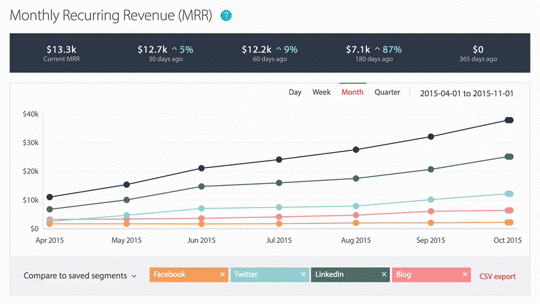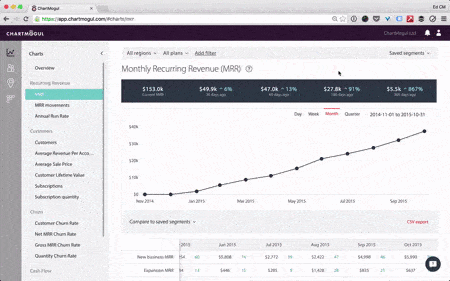Segmentation: The biggest feature launch to date
Last month we announced a set of features that we’d been building and iterating on for some time. Segmentation brought probably the biggest change to functionality in ChartMogul since our public release back in 2014, as well as a world of potential when it comes to optimizing and growing your subscription business.
ChartMogul customers are now creating views of their data such as:
- Monthly Recurring Revenue broken down by marketing channel
- Lifetime Value broken down by NPS score
- Churn Rate broken down by sales rep
…and many more powerful segments. We’re constantly impressed by the different ways in which people are using Segmentation to take their SaaS analytics to the next level.

The initial launch of Segmentation last month was the first step in building out an advanced set of features for segmenting customers in ChartMogul. These features are an ever-evolving set of functionality on which we’re already building future iterations. Today we’re launching an update which further expands the possibilities for Segmentation.
Relative time makes Segmentation more powerful
Today’s update allows you to define a relative time period when adding a custom segment in ChartMogul. Whilst on the surface this seems quite straightforward, it unlocks a whole new set of possible customer segments.
What can I do with it?
It simply means that instead of a fixed date-based period in a segment, which until today was the only option, e.g:
Show me all the customers who signed up since 30/01/2016
…you can now specify a ‘dynamic’, or ‘relative’ time period for the segment, such as:
Show me all the customers who signed up within the last 30 days
Using this, the following segments are now possible:
- All annual customers up for renewal in the next 14 days.
- Customers who upgraded in the past week.
- Customers less than 3 months old with an NPS score lower than ‘4’.
It’s important to remember that segments with rules using relative time-frames are dynamic and will evolve over time. For example, “less than 30 days ago” depends on the current date.
How do I use it?
To use a parameter with a relative time-span, simply add a custom filter to your view in ChartMogul as normal. When you select a date-based parameter (e.g. Next payment) and select the value field, you’ll be able to toggle between the Relative and Calendar-based (fixed) views:
In Relative mode, the following types of rules are possible:
- before [X] days/weeks/months from now
- on or before [X] days/weeks/months from now
- exactly [X] days/weeks/months from now
- after [X] days/weeks/months from now
- on or after [X] days/weeks/months from now
- before [X] days/weeks/months ago
- on or before [X] days/weeks/months ago
- exactly [X] days/weeks/months ago
- after [X] days/weeks/months ago
- on or after [X] days/weeks/months ago
That’s not all…
As well as this we’ve also rolled out two smaller enhancements to Segmentation in the last few weeks:
New parameter: “Didn’t churn within [X] days of purchase”
This allows you to effectively ignore a specific set of customers who churned within a short period after purchasing your product or service. This can be useful in pricing models that include a money-back guarantee, where you don’t consider cancellations within a certain time period as ‘real churn’.
New parameter: MRR (if cancelled uses MRR before churn)
While we’ve had the “Current MRR” attribute available from the start this isn’t so useful if you want to analyse churn rates for example, e.g. what is the churn rate for customers who pay over $100 per month. With Current MRR this excluded all the churned customers because their MRR was $0. With the new attribute MRR (if cancelled uses MRR before churn), the MRR value for churned customers will be equal to the last value before they churned (instead of zero).

